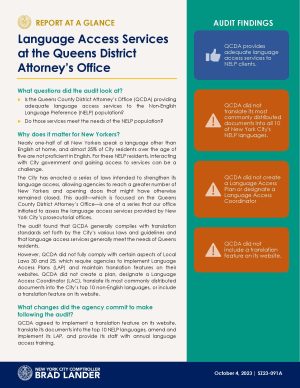Audit Report on the Queens County District Attorney’s Office’s Provision of Language Access Services
A Message from the Comptroller
To the Residents of the City of New York,
My office has conducted an audit of the Queens County District Attorney’s Office’s (QCDA’s) compliance with relevant laws, standards, and guidelines regarding the provision of language access services to the non-English Language Preference (NELP) population. The audit also assessed whether the NELP population was fairly served by QCDA. We conducted this audit to ensure residents with NELP have adequate and effective access to City services and ensure equity and inclusion.
The audit found that QCDA generally complies with the translation standards prescribed by relevant laws, standards, and guidelines, with some exceptions. The language access services provided generally meet the needs of the NELP population as intended, and the NELP population generally has the same access to government services as the English-speaking population. However, QCDA was not fully compliant with certain aspects of Local Law 30 related to Language Access Plans (LAP) and the translation of commonly distributed documents. QCDA was not compliant with Local Law 25 concerning the translation of its website at the time the audit began.
The audit makes five recommendations, including, ensuring that QCDA includes a translation feature on its website that can translate text into the top ten designated citywide languages, ensuring that all documents commonly distributed to the public are translated into the top 10 NYC NELP languages; amending the LAP to include select policies required by Local Law 30 that are missing; and posting the revised LAP and name and title of the Language Access Coordinator with all due expediency and post it to its website, and implement annual language access training for staff.
I am pleased to report that QCDA agreed with the audit findings and recommendations and has already begun implementing the recommendations.
The results of this audit have been discussed with QCDA officials and their comments have been considered in preparing this report. QCDA’s complete written response is attached to this report.
If you have any questions concerning this report, please email my Audit Bureau at audit@comptroller.nyc.gov.
Sincerely,
Brad Lander
Audit Impact
Summary of Findings
The audit found that the Queens County District Attorney’s Office (QCDA) generally complies with the language access standards prescribed by relevant laws, standards, and guidelines, with few exceptions. The language access services provided generally meet the needs of the non-English Language Preference (NELP) population as intended, and the NELP population generally has the same access to government services as the English-speaking population.
However, QCDA was not fully compliant with certain aspects of Local Law 30 of 2017 (LL 30), which relates to Language Access Plans (LAP) and Language Access Coordinators (LAC) and the translation of its most commonly distributed documents and Local Law 25 of 2016 (LL 25) which requires websites maintained by or on behalf of the city or a city agencies to include a translation feature for viewing text in languages other than English. LL 30 appears in Title 23, Chapter 11 Language Access § 23-1101 of the NYC Administrative Code. LL 25 appears in Title 23, Chapter 8, City Website, § 23-801 of the NYC Administrative Code.
Intended Benefits
The audit assessed QCDA’s compliance with relevant laws, standards, and guidelines to ensure residents with NELP have adequate and effective access to City services, assessed whether the NELP population was fairly served by QCDA. The audit identified areas regarding the translation of its most commonly distributed documents, LAP and website where QCDA could improve access to its services.
Introduction
Background
New York City is home to one of the most diverse populations in the world, with more than 3 million foreign-born residents hailing from more than 200 countries. According to the New York City Department of City Planning, nearly one-half of all New Yorkers speak a language other than English at home, and almost 25% of City residents aged five and over are not proficient in English. For residents with a non-English Language Preference (NELP) interacting with City government and receiving access to City services can be a challenge.[1]
Since 2003, the City government has striven to enhance language access for NELP residents through a series of legislative actions including:
- Executive Order No.120 (EO 120): EO120, New York’s “Citywide Policy on Language Access to Ensure Effective Delivery of City Services,” was established in 2008, and required all City agencies providing direct customer services to provide language access services.
- Local Law 25 of 2016 (LL25): LL25 required all City agency websites to include a translation feature for the most widely used languages in the city, other than English.
- Local Law 30 of 2017 (LL30): LL 30 requires all City agencies that provide direct public or emergency services, to designate a Language Access Coordinator and to develop Language Access Plans (LAP).[2] [3] LAPs consist of the following components: identification and translation of the most commonly distributed public documents; interpretive services, including telephonic interpretation in at least 100 languages; training of frontline workers on language access policies; posting of signage in conspicuous locations about the availability of free interpretation services; and the establishment of an appropriate monitoring and measurement system regarding the provision of agency language services. Agencies were also expected to incorporate consideration of language access in public communications (including emergency notifications, public hearings, and events), and craft widely distributed documents using plain language principles. The law also required agencies to update their LAPs every three years.
Federal, state, and local laws and regulations require that district attorney offices provide language support that allows NELP people to meaningfully participate in their programs and activities. The federal government and New York State have also enacted laws and issued guidance that enhance language access, both within the justice system (which the district attorney offices are a part of) and state government. These actions include:
- Federal Executive Order 13166 (EO13166): Signed by the President of the United States in 2000, EO13166 requires federal agencies to develop and implement a system to provide services for the NELP population. It also requires that recipients of Federal financial assistance provide meaningful access to their NELP applicants and beneficiaries. EO13166 also requires federal agencies to comply with United States Department of Justice Guidance that recommends a written plan to address the needs of the NELP population.
- Consolidated Laws of New York, Chapter 18, Article 10, § 202-a (Section 202-a): Section 202-a requires each state agency that provides direct public service to translate all vital documents into the 12 most common non-English languages spoken by NELP individuals in the state, based on data in the most recent American Community Survey published by United States Census Bureau. It requires agencies to provide interpretation services, designate a language access coordinator, and develop an LAP. The LAP shall include the means by which the agency will provide language assistance services, the titles of all available translated documents and the languages into which they have been translated, a training plan for agency employees, plan for annual internal monitoring of the agency’s compliance, and a description of how the agency intends to notify the public of the language services provided.
- New York State Unified Court System Regulations, Part 217 (Part 217): Part 217 of the Uniform Rules for NYS Trial Courts states that the court will provide interpreting services free of charge, in criminal, civil matters, and family court, for all participants in the process, including defendants, parties, witnesses, victims and those who use non-courtroom services provided by the court.
The Queens County District Attorney’s Office (QCDA), also known as the Queens District Attorney’s Office, has the duty to protect the public by investigating and prosecuting criminal conduct in Queens. According to QCDA’s website, its Office of Immigration Affairs (OIA) works diligently with immigrants and international visitors to ensure they understand the legal system and their rights. Through education, outreach, and advocacy, OIA defends the diversity and safety of the Queens’ immigrant community by protecting every person, regardless of their status. More than 30 languages are spoken by the QCDA/OIA staff including English, Spanish, Chinese, Russian, and Vietnamese.
One of the missions of the NYS Unified Court System is to deliver equal justice under the law. To achieve that goal, all New Yorkers must have equal access to the courts and the justice system. The court will provide an interpreter to any party with an interest in a court proceeding, such as a litigant, criminal defendant, or witness, to ensure that they can meaningfully participate in that proceeding. Without interpreters, NELP individuals do not have equal access, and the outcomes of court proceedings could be negatively affected if the information provided by a NELP individual is misunderstood or not properly addressed. The interpreters are provided at no cost to ensure that NELP individuals of any economic means can access the services provided by the courts and its affiliates. The court will also ensure that interpreters are providing fair and impartial interpretation in a professional manner to those who need it.
Objective
The objectives of this audit were to determine whether: (1) QCDA is providing agency services to the non-English Language Preference population in the languages required by relevant laws, standards, and guidelines; and (2) the agency’s language access services meet the needs of the NELP population as intended.
Discussion of Audit Results with QCDA
The matters covered in this report were discussed with QCDA officials during and at the conclusion of this audit. An Exit Conference Summary was sent to QCDA on August 3, 2023, and discussed with QCDA officials at an exit conference held on August 9, 2023. On August 29, 2023, we submitted a Draft Report to QCDA with a request for written comments. We received a written response from QCDA on September 13, 2023. In its response, QCDA agreed with the report’s findings and recommendations, detailing the corrective measures they have taken in response.
The full text of QCDA’s response is included as an addendum to this report.
Detailed Findings
The audit found that QCDA generally complies with the interpretation standards prescribed by relevant laws, standards, and guidelines, with some exceptions. The language access services provided generally meet the needs of the NELP population as intended, and the NELP population generally has the same access to government services as the English-speaking population.
However, QCDA was not fully compliant with certain aspects of LL 30 and LL 25. Specifically, QCDA did not ensure translation of its most commonly distributed documents into the top 10 NELP languages, did not create a language access plan (LAP), and did not include a translation feature on their website. These are discussed below.
QCDA Generally Provides Language Access Services to NELP Clients as Required
The auditors found that QCDA:
- Provides language access services to NELP clients. QCDA has a service agreement with Language Line Solutions, an interpretation and translation service provider that can provide interpretation in over 240 languages, including the top 10 NYC NELP languages. QCDA frontline staff can access Language Line from any phone. Multi-lingual staff can also provide interpretation and translation services. If staff translate a document that must be submitted to court, it must be submitted along with an affirmation of translation. QCDA can also use court approved per-diem interpreters to provide language access to those who need it.
- Notifies the public of the right to free interpretation services. QCDA maintains multiple publicly accessible offices. At each location a language identification sign and a sign notifying the public of their right to a free interpreter are posted in conspicuous locations. The language identification sign instructs the reader to point to their preferred language so that an interpreter can be provided at no cost. The language identification sign is translated into 36 languages including English and the top 10 NYC NELP Languages. The sign informing the reader of the right to a free interpreter is translated into 34 languages including English and the top 10 NYC NELP Languages.
QCDA Was Not in Compliance with Web Translation Requirements of LL 25
At the time the audit began, QCDA’s website did not have translation feature. Auditors notified QCDA that their website was required to have a translation feature at a meeting held on March 23, 2023. QCDA acknowledged and informed auditors that they were working toward a solution.
At a follow-up meeting on June 8, 2023, QCDA demonstrated the progress of the translation feature, but it is not yet publicly available. The website was translatable into 14 languages (Arabic, Bengali, Chinese [simplified and traditional], French, Hindi, Italian, Korean, Polish, Punjabi, Russian, Spanish, Urdu, and Hebrew). Auditors advised QCDA that Haitian Creole is one of the top 10 designated citywide languages and should be included on QCDA’s website to be compliant with both LL 25 and LL 30. As of July 19, 2023, the redesigned website was not publicly available.
During the exit conference held on August 9, 2023, QCDA informed auditors that they had added the translation feature to the publicly available website and added Haitian Creole to the list of available languages for translation. Auditors confirmed that the translation feature was available, and that the website was translatable into the top ten designated citywide languages.
QCDA Was Not in Compliance with Several Key Aspects of LL 30
Most Commonly Distributed Documents Not Translated into All Top 10 NYC NELP Languages
LL 30 requires agencies to identify and translate documents that are most commonly distributed to the public. When QCDA initially responded to auditor requests for the most commonly distributed documents, QCDA submitted a “Call me letter” sent to victims of a crime (translated into English and Spanish), a “Census fraud” flier (translated into English, Spanish, and Korean), a “contact card” (translated into English, Spanish, Mandarin, and Bengali), a “Crime Victims Advocate Program (CVAP)” brochure (translated into English, Spanish, and Bengali), a “housing fraud” flier (translated into English and Spanish), a general “Letter” from an Assistant District Attorney (ADA) (translated into English and Spanish), an “Office of Immigrant Affairs (OIA)” brochure (translated into English, Spanish, and Mandarin), a “Subpoena” (translated into English and Spanish), and a “Tip Card” (translated into Spanish, Mandarin, and Bengali).
In response to a follow-up request, QCDA submitted additional documents it had identified as being commonly distributed. Those documents included a letter to witnesses informing them how to respond to a defense attorney if contacted, a “Call Me” letter, a CVAP brochure, a CVAP “Guide to Restitution,” a CVAP “Information Sheet,” a CVAP “Informed Waiver,” a CVAP “Informed Consent,” and CVAP “Order of Protection” flyer. All documents received in response to the follow-up request, had been translated into Arabic, Bengali, Chinese (traditional and simplified), French, Haitian Creole, Hindi, Italian, Korean, Polish, Punjabi, Russian, Spanish, Urdu, and Yiddish, with one exception.[4]
QCDA should provide its most commonly distributed documents in all required languages, as well as any additional languages that reflect its community, and should use its contracted language service providers to translate documents as needed.
At the exit conference, QCDA informed auditors that it will continue to update their most commonly distributed documents and translate them in compliance with relevant laws, standards, and guidelines.
QCDA’s Language Access Plan Not Fully Compliant with LL 30
Language access plans (LAP) used for the provision of interpretation and translation services ensure both equal access to government services for English speaking and NELP individuals and agency compliance with applicable laws and regulations. However, QCDA had not created or implemented a language access plan or designated a language access coordinator (LAC) prior to this audit.
At the beginning of the audit, QCDA did not have an LAP or an LAC. During a meeting that took place on May 24, 2023, auditors were informed that QCDA’s Chief Diversity Officer had been designated as the LAC. QCDA also informed auditors at that meeting that an LAP was in development.
On June 8, 2023, auditors held a meeting with QCDA staff during which QCDA demonstrated progress on their webpage and presented a draft copy of their LAP. During the demonstration of their webpage, QCDA displayed the page that would include the name and title of the LAC. Auditors confirmed that the webpage containing the name and title of the LAC would be publicly available by June 27, 2023.
The draft copy of the LAP complied with the “four factors clause” of LL 30, as delineated by guidance issued by the U.S. Department of Justice. The draft effectively (1) considered the size of the NELP population likely to be served; (2) considered the frequency with which NELP individuals came into contact with the agency; (3) considered the importance of the service provided; and (4) considered the resources available.
The LAP, once implemented, will also ensure that QCDA complies with other key aspects of LL 30 by including policies that outline how the office will provide language access services. The LAP also includes policies to ensure staff receive annual training related to providing language access services.
However, several key aspects required by LL 30 were not addressed in QCDA’s LAP at that time, including that QCDA will:
- Ensure the policy is updated at least once every three years.
- Plan for addressing language access in their emergency preparedness response.
- Include policies for providing language access in public communications, such as emergency notifications, public hearings and events, and press releases.
A plan that incorporates all aspects required by LL 30 would more effectively support the agency in ensuring fair, equitable, and meaningful access to services that are fundamental to justice and civil liberties.
A draft of QCDA’s training manual was also presented to auditors during the June 8 virtual meeting. The manual included topics such as relevant laws and regulations, the importance of language access to ensure equal access to justice, and how to contact, effectively work with, and address problems with interpreters. At that time, no training session had been scheduled.
At the exit conference held on August 9, 2023, QCDA informed auditors that they had amended the LAP to ensure that language access was considered in emergency preparedness planning and in all public communications. QCDA also included language to require that the LAP is updated at least once every three years. The amended LAP was posted to QCDA’s website along with the name, title, and contact info for QCDA’s LAC.
QCDA also informed auditors that language access training had been scheduled but the training had not taken place at the time the exit conference was held.
In their response, QCDA stated, “the Language Access Coordinator conducted a training of frontline staff on August 22, 2023.” QCDA also stated, “training will be scheduled annually moving forward.”
Recommendations
To address the findings, the auditors propose that QCDA:
- Ensure that their website contains a translation feature that can translate text into the top 10 NYC NELP languages.
QCDA Response: The agency agreed with this recommendation. - Ensure that all of its most commonly distributed documents are available in the top 10 NYC NELP languages and additional languages that reflect the needs of the local NELP community.
QCDA Response: The agency agreed with this recommendation. - Amend the language access plan to include policies (1) for updating the LAP at least once every three years; (2) addressing language access in their emergency preparedness response; and (3) for incorporating language access into all public communications.
QCDA Response: The agency agreed with this recommendation. - Implement the revised language access plan with all due expediency and post it on its website.
QCDA Response: The agency agreed with this recommendation. - Conduct annual language access training for all frontline staff and management personnel.
QCDA Response: The agency agreed with this recommendation.
Recommendation Follow-up
Follow-up will be conducted periodically to determine the implementation status of each recommendation contained in this report. Status updates are reported in the Audit Recommendations Tracker available here: https://comptroller.nyc.gov/services/for-the-public/audit/audit-recommendations-tracker/
Scope and Methodology
We conducted this performance audit in accordance with Generally Accepted Government Auditing Standards (GAGAS). GAGAS requires that we plan and perform the audit to obtain sufficient, appropriate evidence to provide a reasonable basis for our findings and conclusions based on our audit objectives. We believe that the evidence obtained provides a reasonable basis for our findings and conclusions within the context of our audit objectives. This audit was conducted in accordance with the audit responsibilities of the City Comptroller as set forth in Chapter 5, § 93, of the New York City Charter.
The scope period was from January 1, 2018, through August 9, 2023.
To achieve the audit objectives, auditors performed the following:
- Reviewed relevant criteria including:
- NYC Administrative Code, Title 8, Chapter 10, Equal Access to Human Services §8-1002 (LL73);
- NYC Executive Order No. 120 July 22, 2008 (EO120): “Citywide Policy on Language Access to Ensure Effective Delivery of City Services;
- NYC Administrative Code, Title 23, Chapter 8, City Website, § 23-801 (LL 25)).
- NYC Administrative Code, Title 23, Chapter 11, Language Access § 23-1101 (LL 30)
- US Executive Order 13166 of August 11, 2000 (EO13166), Improving Access to Services for Persons with Limited English Proficiency;
- New York State Unified Court System Regulations, Part 217 (Part 217) Administrative Rules of the Unified Court System & Uniform Rules of the Trial Courts;
- S. Department of Justice (DOJ) effective June 12, 2002 (67 FR 41455). 67 FR 41455;
- American Bar Association Standards for Language Access in Courts; and
- Consolidated Laws of New York, Chapter 18, Article 10, § 202-a (Section 202-a) Section § 202-a.
- Created compliance checklists to assess QCDA’s compliance with LL30.
- Conducted interviews and walkthroughs with key QCDA personnel involved with the provision of language access service.
- Reviewed and assessed whether QCDA’s Language Access Plan was developed in accordance with LL 30, using the required four-factor analysis.
- Tested whether QCDA provided direct public services in at least the top 10 NELP languages spoken by the New York City population by (1) reviewing QCDA’s Language Access Plan; (2) conducting visits at QCDA’s locations; and (3) conducting interviews with pertinent personnel regarding the provision of language access services.
- Obtained and reviewed documentation and assessed whether QCDA identified and translated the agency’s most commonly distributed public documents.
- Conducted site visits to QCDA’s locations in Queens to observe QCDA’s translation services and ensure equity and inclusion for QCDA’s NELP clients. To accomplish this, auditors (1) checked for the required signage and multilingual documents; (2) interviewed pertinent personnel regarding the provision of language access services on the process of providing language access; and (3) obtained and reviewed the employee manual for language access training and/or written policies and procedures.
- Reviewed QCDA signage kits to determine whether they contained multilingual posters.
- Reviewed and assessed whether QCDA established an appropriate monitoring and measurement system regarding the provision of agency language services.
- Reviewed and assessed whether QCDA created appropriate public awareness strategies for the agency’s serviced NELP population by visiting QCDA’s locations to determine whether the required notification of the right of free interpretation services is posted in conspicuous locations. Auditors observed various QCDA documents notifying the public of the right to interpretation such as the posters on the wall.
- Reviewed whether QCDA’s Language Access Plan and name and title of the designated Language Access Coordinator are posted to its website.
- Accessed QCDA’s website and translated the information into the top 10 languages spoken in New York City.
- Determined whether it was appropriate to conduct a Client Survey to ascertain whether QCDA NELP clients were able to receive services in their preferred NELP language. Auditors discussed the potential for a survey with QCDA at the Entrance Conference and a Walkthrough site observation meeting. Auditors informed QCDA that the survey would not include identifying questions or any details about the reasons survey participants had sought services from QCDA. QCDA expressed concerns about a Client Survey, stating that any material discussed or answers to the survey questions would have to be disclosed to the defendants and their attorneys, which may have a negative impact on ongoing cases. Given this, and other concerns, it was determined that including or conducting NELP surveys would be inappropriate for QCDA’s language access audit.
Appendix
QCDA LANGUAGE ACCESS COMPLIANCE OBSERVATIONS
#1 QCDA SIGNAGE
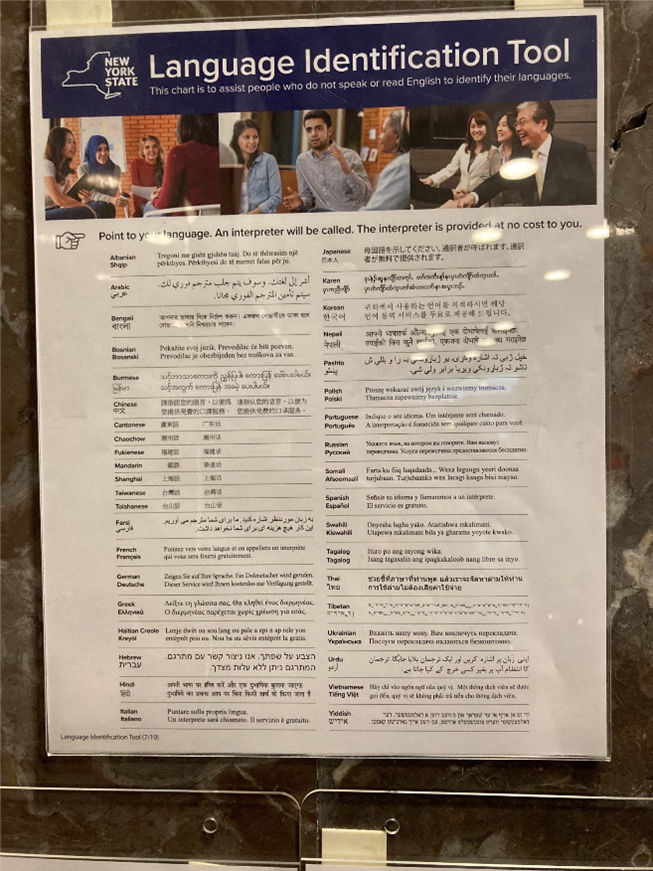
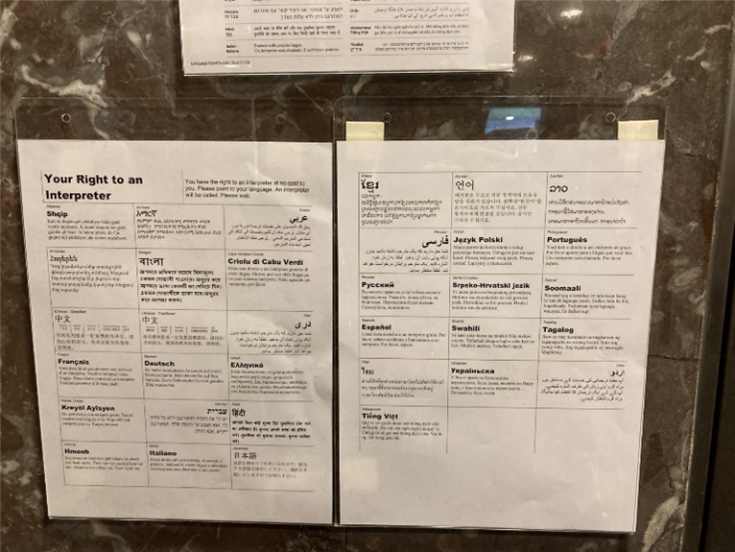
QCDA signage is conspicuously placed and notifies the public of the availability free interpretation services in QCDA locations.
#2: QCDA DOCUMENTS AVAILABLE IN MULTIPLE LANGUAGES
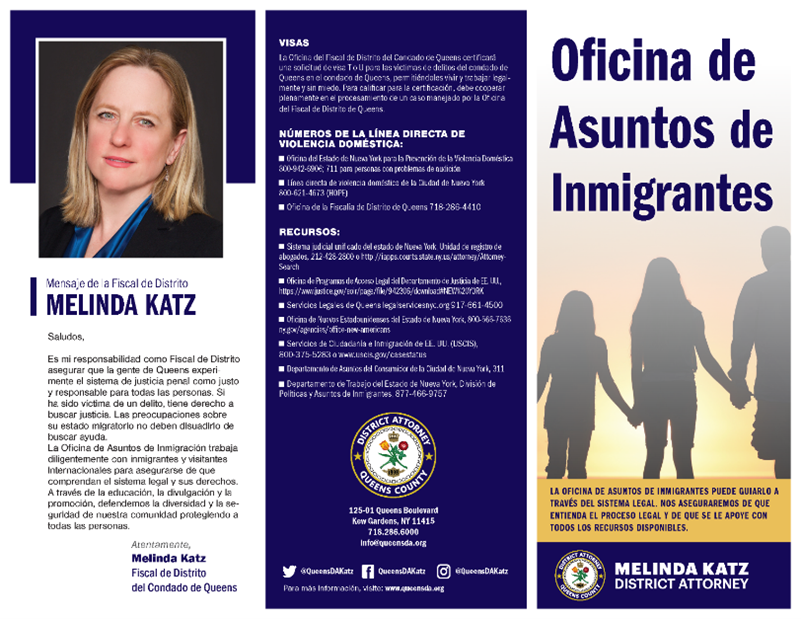

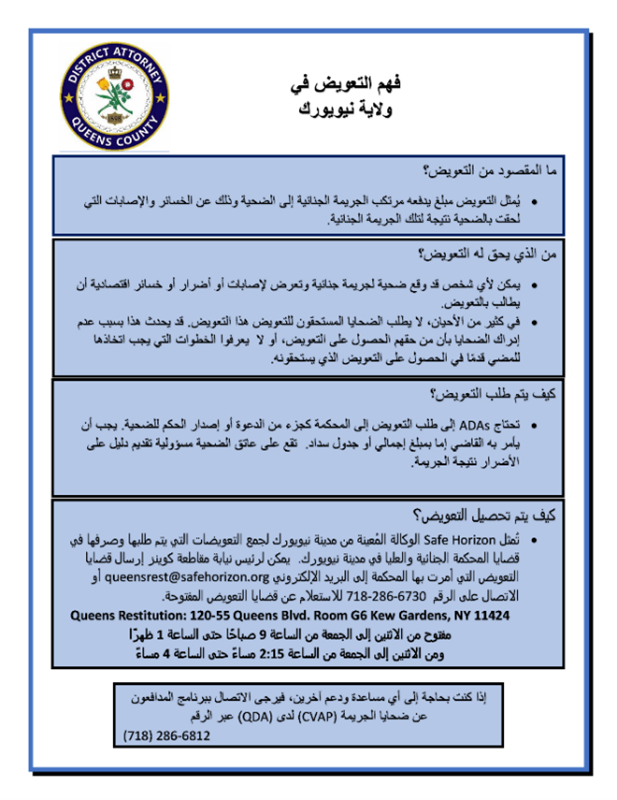
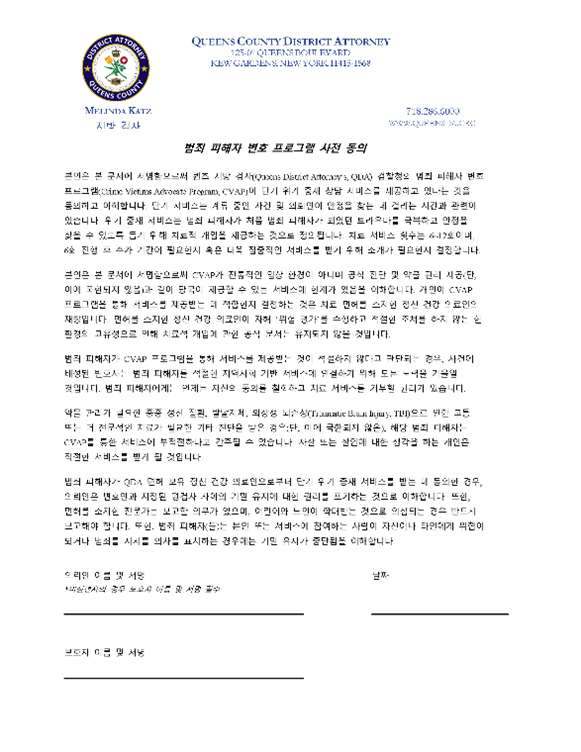
Endnotes
[1] NYC Administrative Code, Title 8, Chapter 10, Equal Access to Human Services, § 8-1002, Local Law 73 of 2003 (LL73), LL30, and EO120 use the term “limited English proficient” or “LEP”; however, for the purposes of this report, the term “non-English language preference” (or “NELP”) is used.
[2] City agencies that receive Federal funding, including QCDA, must apply a four-factor analysis when developing their LAPs. This is based on guidance issued by the U.S. Department of Justice,.(U.S. Department of Justice (DOJ) effective June 12, 2002 (67 FR 41455). These factors include: the number or proportion of NELP persons in the eligible service population; the frequency with which NELP individuals come into contact with the agency; the importance of the benefit, service, information, or encounter to the NELP person; and the resources available to the agency and the costs of providing various types of language services.
[3] US Executive Order 13166 of August 11, 2000 (EO13166), Improving Access to Services for Persons with Limited English Proficiency, requires agencies to prepare a plan to improve access to their programs and activities. The American Bar Association also recommends the development and use of Language Access Plans. New York State Executive Chapter 18, Article 10, § 202-a requires agencies to develop a Language Access Plan.
[4] QCDA did not submit a Yiddish translation of the CVAP Brochure. Yiddish is not one of the top 10 NYC NELP languages.
